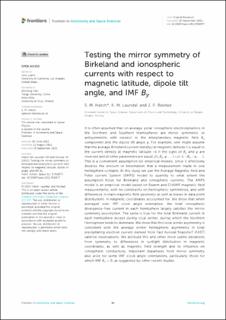| dc.contributor.author | Hatch, Spencer Mark | |
| dc.contributor.author | Laundal, Karl Magnus | |
| dc.contributor.author | Reistad, Jone Peter | |
| dc.date.accessioned | 2023-03-13T12:49:34Z | |
| dc.date.available | 2023-03-13T12:49:34Z | |
| dc.date.created | 2022-11-17T14:27:22Z | |
| dc.date.issued | 2022 | |
| dc.identifier.issn | 2296-987X | |
| dc.identifier.uri | https://hdl.handle.net/11250/3057963 | |
| dc.description.abstract | It is often assumed that on average, polar ionospheric electrodynamics in the Northern and Southern Hemispheres are mirror symmetric or antisymmetric with respect to the interplanetary magnetic field By component and the dipole tilt angle ψ. For example, one might assume that the average Birkeland current density j at magnetic latitude λ is equal to the current density at magnetic latitude −λ if the signs of By and ψ are reversed and all other parameters are equal: j(λ, By, ψ, … ) = j(−λ, −By, −ψ, … ). This is a convenient assumption for empirical models, since it effectively doubles the amount of information that a measurement made in one hemisphere contains. In this study we use the Average Magnetic field and Polar current System (AMPS) model to quantify to what extent the assumption holds for Birkeland and ionospheric currents. The AMPS model is an empirical model based on Swarm and CHAMP magnetic field measurements, with no constraints on hemispheric symmetries, and with differences in main magnetic field geometry as well as biases in data point distributions in magnetic coordinates accounted for. We show that when averaged over IMF clock angle orientation, the total ionospheric divergence-free current in each hemisphere largely satisfies the mirror symmetry assumption. The same is true for the total Birkeland current in each hemisphere except during local winter, during which the Northern Hemisphere tends to dominate. We show that this local winter asymmetry is consistent with the average winter hemispheric asymmetry in total precipitating electron current derived from Fast Auroral SnapshoT (FAST) satellite observations. We attribute this and other more subtle deviations from symmetry to differences in sunlight distribution in magnetic coordinates, as well as magnetic field strength and its influence on ionospheric conductivity. Important departures from mirror symmetry also arise for some IMF clock angle orientations, particularly those for which IMF Bz > 0, as suggested by other recent studies. | en_US |
| dc.language.iso | eng | en_US |
| dc.publisher | Frontiers | en_US |
| dc.rights | Navngivelse 4.0 Internasjonal | * |
| dc.rights.uri | http://creativecommons.org/licenses/by/4.0/deed.no | * |
| dc.title | Testing the mirror symmetry of Birkeland and ionospheric currents with respect to magnetic latitude, dipole tilt angle, and IMF By | en_US |
| dc.type | Journal article | en_US |
| dc.type | Peer reviewed | en_US |
| dc.description.version | publishedVersion | en_US |
| dc.rights.holder | Copyright 2022 The Author(s) | en_US |
| dc.source.articlenumber | 958977 | en_US |
| cristin.ispublished | true | |
| cristin.fulltext | original | |
| cristin.qualitycode | 1 | |
| dc.identifier.doi | 10.3389/fspas.2022.958977 | |
| dc.identifier.cristin | 2075697 | |
| dc.source.journal | Frontiers in Astronomy and Space Sciences | en_US |
| dc.relation.project | Norges forskningsråd: 300844 | en_US |
| dc.identifier.citation | Frontiers in Astronomy and Space Sciences. 2022, 9, 958977. | en_US |
| dc.source.volume | 9 | en_US |

